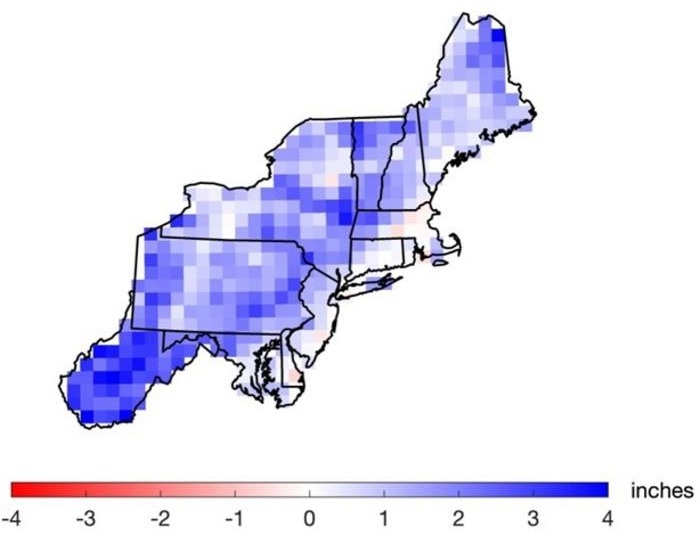According to recent Dartmouth research, extreme precipitation events—defined as 1.5 or more inches of heavy rainfall or melted snowfall in a day—are anticipated to increase by 52% in the Northeast by the end of the century as the climate warms.

Extreme precipitation change between 2070–2099 and 1996–2005. Image Credit: C. Picard et al.
The study has been published in the journal Climatic Change.
As climate change brings warmer temperatures, you have more water vapor in the atmosphere, which creates the right conditions for extreme precipitation. Our findings show that this increase in extreme precipitation will be primarily driven by more frequent heavy rainfall events, not by the intensity of such events. In other words, we expect a large increase in the number of extreme precipitation days and a smaller increase in the amount of rain on each extreme precipitation day.
Christopher J. Picard, Undergraduate Researcher, Earth Sciences, Applied Hydroclimatology Group, Dartmouth College
The results also suggest that winter and spring contribute the most to the region’s anticipated 52% rise in extreme precipitation from 2070 to 2099, with 109% and 89% increases, respectively.
Earlier, senior author Jonathan Winter, an Associate Professor of Geography and the Director of Dartmouth’s Applied Hydroclimatology Group, and colleagues explored how severe rainfall episodes in the Northeast have evolved through time. They discovered a 50% rise in extreme precipitation from 1996 to 2014 by studying data from 1901 to 2014, and the increase was connected to climate change.
“Building on our earlier work, we were particularly interested in determining how much extreme precipitation is expected to change across the Northeast in the future,” notes Winter.
The recent study describes the Northeast as Maine, Vermont, New Hampshire, Connecticut, Massachusetts, New Jersey, Rhode Island, Pennsylvania, New York, Maryland, Delaware, West Virginia, and Washington, D.C.
According to the Dartmouth study, extreme precipitation increases will be greatest in West Virginia, sections of Pennsylvania, central New York, and northeastern Maine, with primarily lesser increases along the Atlantic coast and south of Lake Ontario.
The investigators used a regional climate model from the National Center for Atmosphere Research to simulate precipitation from 1996 to 2005 and from 2070 to 2099. The researchers then compared their findings to simulations of varying heavy rainfall events from other regional climate models, discovering that their findings are consistent with the other regional climate model simulations, which anticipate rises in extreme precipitation ranging from 58% to 169%.
“Extreme precipitation events can pose threats to life, property, infrastructure, and the environment,” adds Winter.
Earlier studies have shown how these events’ flooding, landslides, and erosion can wash out roads, cause agricultural runoff of pollutants, and destroy recreational areas.
“So, understanding where the flood plain is actually located, having the right sized culverts or green infrastructure in place, and properly designing roads and bridges, are important to managing the extra water that we're likely to encounter in the future,” he concludes.
Journal Reference
Picard, C. J., et al. (2023). Twenty-First Century Increases in Total and Extreme Precipitation across the Northeastern USA. doi.org/10.1007/s10584-023-03545-w.